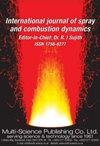脉冲热流点燃多分散喷雾火焰
IF 2.1
4区 工程技术
Q3 ENGINEERING, MECHANICAL
International Journal of Spray and Combustion Dynamics
Pub Date : 2021-05-31
DOI:10.1177/17568277211014105
引用次数: 0
摘要
提出了一种多分散喷雾/空气混合物在脉冲加热的无限表面下点火的数学分析方法。与以往的文献工作不同,本文叙述了整个点火过程的历史,从火焰胚祖阶段开始,经过热失控阶段,最后到火焰传播阶段。在当前阶段,化学动力学被认为是一个单一的全局反应的动力学。采用截面法对喷雾进行建模,确定了燃油喷射特性对点火的影响。在理论预测和完整的数值模拟之间发现了很好的一致性。在某些操作条件下,由于燃料液滴的蒸汽积聚以及液滴蒸发的热量损失而导致的点火延迟被发现起着重要的作用。临界能量通量与初始喷雾多分散性的比较表明,脉冲持续时间较大时差异较小,而脉冲持续时间较小时差异较大。尽管这些看似微小的差异,但研究表明,即使对于具有相同初始SMD的喷雾,初始喷雾的多分散性也会对火焰点燃是否发生或失败产生关键影响。本文章由计算机程序翻译,如有差异,请以英文原文为准。
Polydisperse spray flame ignition by a pulsed heat flux
A mathematical analysis of the ignition of a polydisperse spray/air mixture by an infinite surface heated in a pulsed manner is presented. In contrast to previous work in the literature, the entire history of the ignition process is accounted for starting from the flame-embryo progenitor stage, through the thermal runaway stage to the final flame propagation stage. For tractability at the current stage, the chemical kinetics is taken to be that of a single global reaction. The spray is modeled using the sectional approach and the influence of fuel spray characteristics on ignition is determined. Good agreement was found between the theoretical predictions and full numerical simulations. Delay in ignition due to the build-up of vapor from the fuel droplets as well as heat loss to the droplets for evaporation are found to play a significant role under certain operating conditions. Comparison between the critical energy flux and the initial spray polydispersity revealed small differences for larger values of the pulse duration but more significant minor differences for smaller pulse durations. Despite these seemingly minor differences, it was shown that the initial spray polydispersity can have a critical influence on whether flame ignition will occur or fail, even for sprays having the same initial SMD.
求助全文
通过发布文献求助,成功后即可免费获取论文全文。
去求助
来源期刊

International Journal of Spray and Combustion Dynamics
THERMODYNAMICS-ENGINEERING, MECHANICAL
CiteScore
2.20
自引率
12.50%
发文量
21
审稿时长
>12 weeks
期刊介绍:
International Journal of Spray and Combustion Dynamics is a peer-reviewed open access journal on fundamental and applied research in combustion and spray dynamics. Fundamental topics include advances in understanding unsteady combustion, combustion instability and noise, flame-acoustic interaction and its active and passive control, duct acoustics...
 求助内容:
求助内容: 应助结果提醒方式:
应助结果提醒方式:


